Adaptive Sports And Recreational Activities For People With Autism
Opening Perspectives on Adaptive Activities for Autism
Adaptive sports and recreational activities serve as vital tools in fostering social, emotional, and physical development for individuals with autism. These activities provide structured, supportive environments where participants can build skills, form connections, and enjoy a sense of accomplishment. By integrating modifications and personalized approaches, communities and organizations are creating inclusive spaces that cater to diverse needs, promoting lifelong health and well-being.
Understanding the Benefits of Adaptive Sports and Recreation for Autism
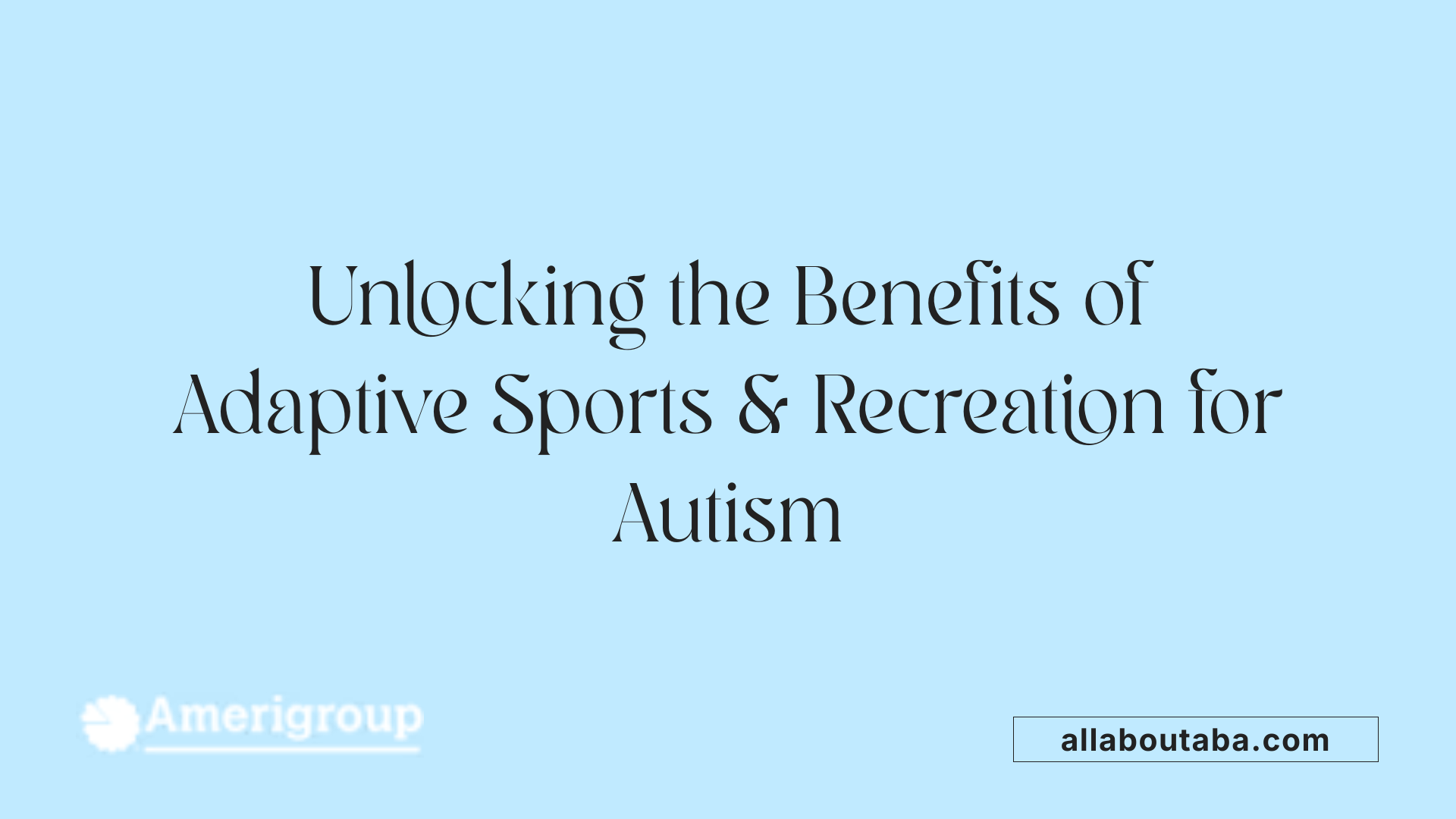
What are the benefits of adaptive sports and recreational activities for people with autism?
Engaging in adaptive sports and recreational activities can have a profound impact on individuals with autism. These activities help improve motor skills, which are crucial for coordination, balance, and overall physical development.
Participation in physical activities also enhances health by promoting cardiovascular fitness, muscle strength, and flexibility. For example, swimming, horseback riding, and adaptive skiing are tailored to fit individual needs while encouraging physical growth.
Beyond physical benefits, these activities support emotional well-being by reducing stress and anxiety. They provide a safe space for self-expression and emotional regulation, often leading to increased self-confidence.
Social interaction is another major advantage. Sports like group basketball, social skills clubs, and team-based outdoor adventures foster friendships, communication, and cooperation. These interactions help develop social cues and teamwork skills.
Adaptive sports encourage independence by teaching skills such as self-advocacy, organizing equipment, and daily living tasks. This sense of autonomy boosts confidence in managing everyday challenges.
Community involvement is promoted as individuals connect with peers, coaches, and organizations dedicated to accessible recreation. Participating in programs like the Wounded Warrior Project or High Fives Foundation makes inclusive activities more accessible.
Activities such as scuba diving, sled hockey, and rock climbing are modified with adaptive equipment to suit physical abilities, making them inclusive options that open up new experiences.
Research consistently shows that exercise can improve motor and social skills in individuals with autism. It also supports sensory integration and emotional regulation, leading to a better quality of life.
Overall, adaptive sports and recreation foster a sense of belonging, promote health, and build skills that translate into greater independence and community involvement, enriching the lives of autistic individuals.
Diverse Adaptive Sports and Recreational Programs Suitable for Autism
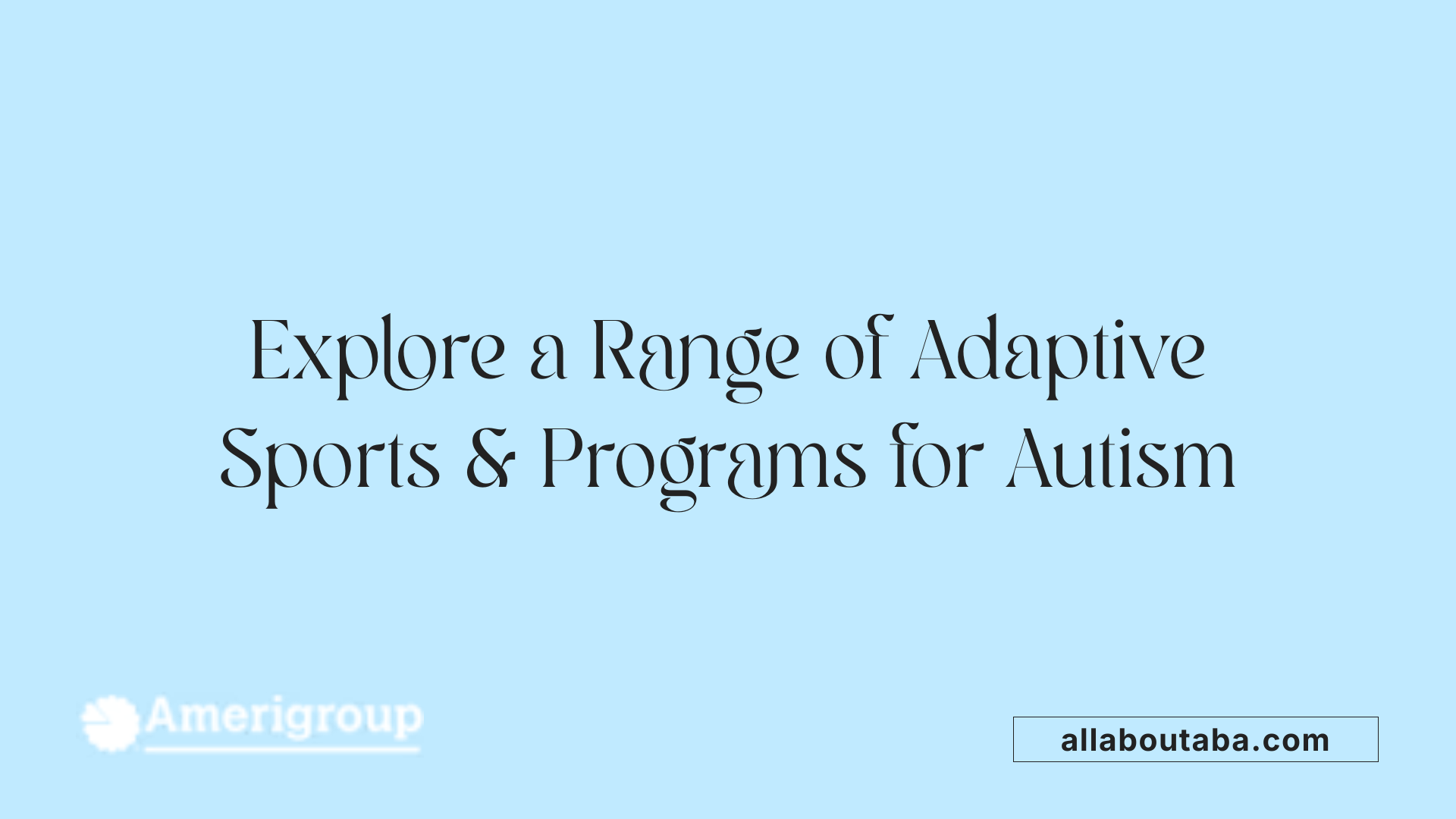
What types of adaptive sports and recreational programs are suitable for individuals with autism?
Adaptive sports and activities provide an array of options tailored to meet the needs of individuals with autism. These programs often include activities like swimming, horseback riding, wheelchair sports, martial arts, and team sports adapted with specific modifications.
For example, the Special Olympics offers a welcoming environment where sports such as tennis, basketball, and track are adapted to ensure accessibility and safety. Challenger Baseball creates an inclusive setting for baseball, incorporating rules and equipment adjustments that accommodate various skill levels.
Equine-assisted therapy or therapeutic horseback riding promotes sensory integration, muscle tone, and balance while fostering emotional connection and boosting confidence. Water activities like swimming help improve motor skills and stamina, and are often supported through specialized programs.
Many organizations develop their activities with the aid of modified equipment, lower physical barriers, and inclusive rules to foster engagement. Coach training is essential, with staff learning to recognize individual needs and adapt their instruction accordingly.
The diversity of these programs ranges from indoor activities such as martial arts classes and art therapy, to outdoor experiences like hiking, camping, and sled hockey in winter. Fitness programs, summer and winter sports tailored to different abilities, and water-based activities are also popular options.
All these activities aim to enhance physical fitness, promote social interaction, and develop emotional resilience, making recreation a vital part of life for individuals with autism. Inclusion and accessibility remain at the core of program design, encouraging lifelong participation and fostering a sense of community.
Strategies for Making Activities Truly Inclusive
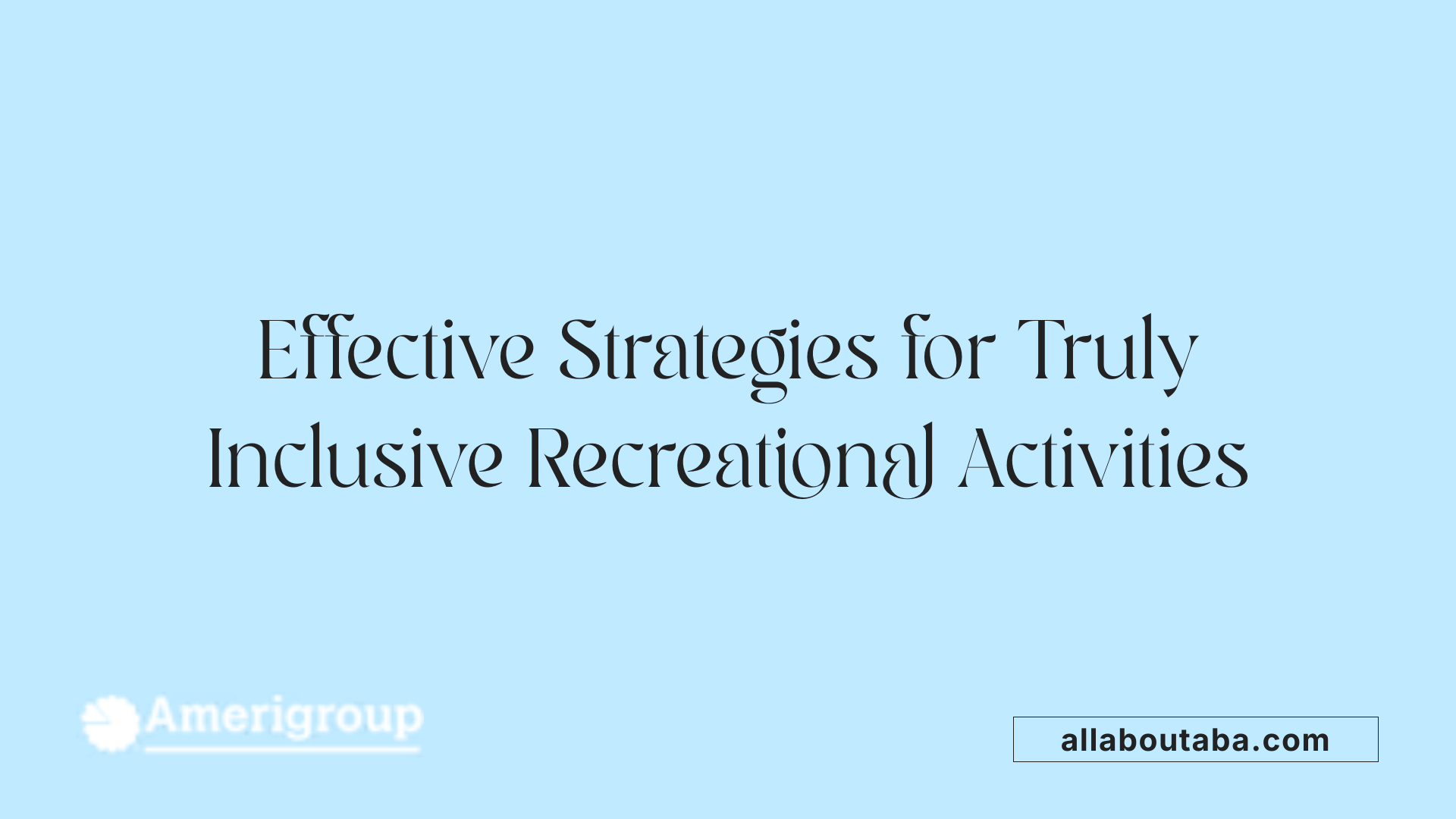
What are effective strategies for making sports and recreational activities inclusive for individuals with autism?
Creating inclusive environments for autistic individuals in recreational settings requires thoughtful planning and adaptable strategies. Involving autistic participants and their families from the outset is essential. Their insights help organizers understand specific needs, preferences, and comfort levels, leading to tailored activities that foster engagement.
Using visual supports such as schedules, communication boards, and PECS (Picture Exchange Communication System) can significantly enhance understanding and reduce anxiety. These tools provide predictability and clarity, which are especially helpful during physical activities that may otherwise be overwhelming.
Sensory accommodations play a vital role. Adjusting lighting to dim or diffuse harsh lights, reducing noise levels, and controlling other sensory inputs help create a calmer, more welcoming environment. Implementing flexible rules and instructions, including simplifying game procedures and allowing alternative ways to participate, ensures that everyone can enjoy the activity.
Training staff and volunteers in autism awareness and responsiveness equips them to better support participants with diverse needs. They learn to interpret non-verbal cues, practice patience, and provide encouragement, fostering a supportive atmosphere.
Flexibility in program structure is crucial. Offering choices within activities, allowing for breaks, and providing autonomy help build confidence and independence.
Finally, creating accessible spaces with low-cost adjustments—such as noise-canceling headphones or visual cues—can make a significant difference. Collaborating with local autism organizations ensures that programs stay responsive and effective.
By integrating these strategies, community programs can promote genuine inclusion, enabling autistic individuals to participate fully, build relationships, and enjoy all the benefits that recreational activities offer.
Resources and Organizations Supporting Adaptive Sports for Autism
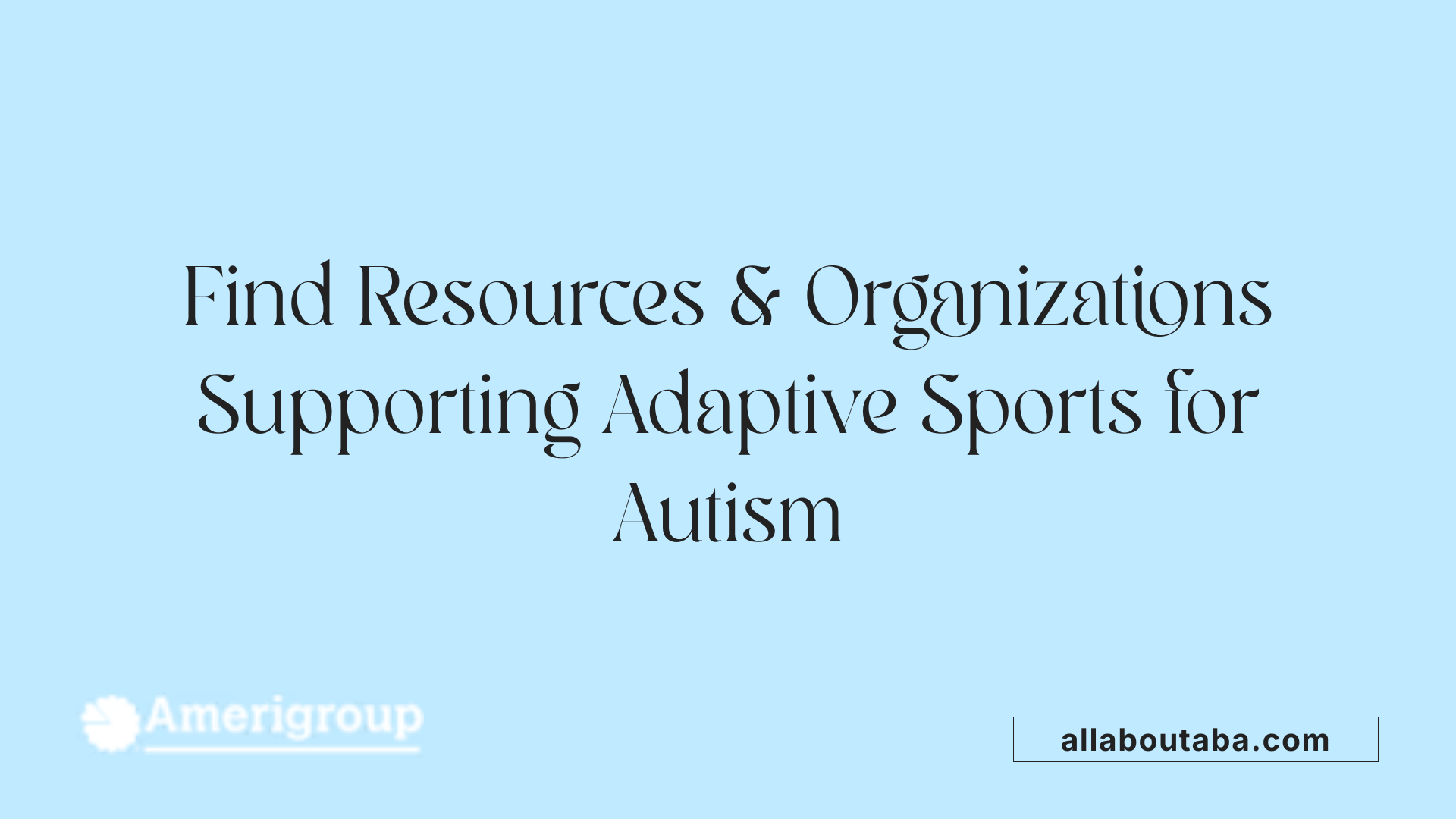
What resources and organizations offer adaptive sports and activities for individuals with autism?
Many organizations across the United States are dedicated to providing inclusive and accessible sports opportunities for individuals with autism. One prominent example is the Adapted Athletic Association of the United States (AAASP). Since 1996, AAASP has been focusing on creating adapted sports programs that promote participation among students with disabilities, including autism. Their work involves training coaches to ensure safe and inclusive environments and collaborating with educational institutions to integrate adaptive sports into school programs.
Another significant organization is Move United, which supports over 248 member programs across 45 states. This organization offers a range of recreational and competitive sports activities tailored for people with disabilities, aiming to foster physical health, social skills, and confidence. Move United's programs include community-based activities as well as high-level competitions, ensuring that individuals with autism can find suitable options regardless of their location.
Locally, the Autism Society Greater Detroit plays an important role in connecting individuals and families to adaptive sports programs. They provide information about various activities such as Adaptive Youth Sports Organization (AYSO) VIP soccer, adaptive skiing, kayaking, and baseball programs like Little League Challenger and Miracle League. These efforts help children and adults with autism engage in physical activity while building social connections.
Partnerships with educational and community entities
Many of these organizations work closely with schools, local recreation departments, and community centers to expand access. Schools often partner with adaptive sports programs to include students with autism in physical education and extracurricular activities.
Availability of programs across regions
Adaptive sports programs are increasingly available across different regions, thanks to these collaborations. They employ specialized equipment and techniques to modify traditional sports to meet the needs of participants with disabilities. As a result, individuals with autism can enjoy sports like wheelchair basketball, adaptive golf, sled hockey, hand cycling, and even scuba diving, all with proper accommodations.
Supporting evidence and further resources
Research consistently shows that participation in adaptive sports improves physical health, social skills, and confidence for individuals with autism. Resources like the CDC also report a growing number of accessible programs across the nation.
For families and caregivers interested in exploring options, searching terms such as "adaptive sports programs for autism" or "inclusive recreational activities" in local areas can reveal more opportunities.
| Organization Name | Programs Offered | Region Served | Additional Services |
|---|---|---|---|
| AAASP | Inclusive sports training, coaching, collaboration | Nationwide | Coach training, school partnerships |
| Move United | Recreational and competitive sports, education | 45 states | Community outreach, adaptive equipment support |
| Autism Society Greater Detroit | Youth sports, adaptive skiing, kayaking, baseball | Detroit area | Family support, local program connections |
Participating in adaptive sports not only promotes physical health but also fosters social inclusions and boosts self-esteem. These organizations are instrumental in creating opportunities that transform lives, offering individuals with autism a chance to engage more fully with their communities.
How Recreation Therapy Enhances Social Skills, Confidence, and Independence
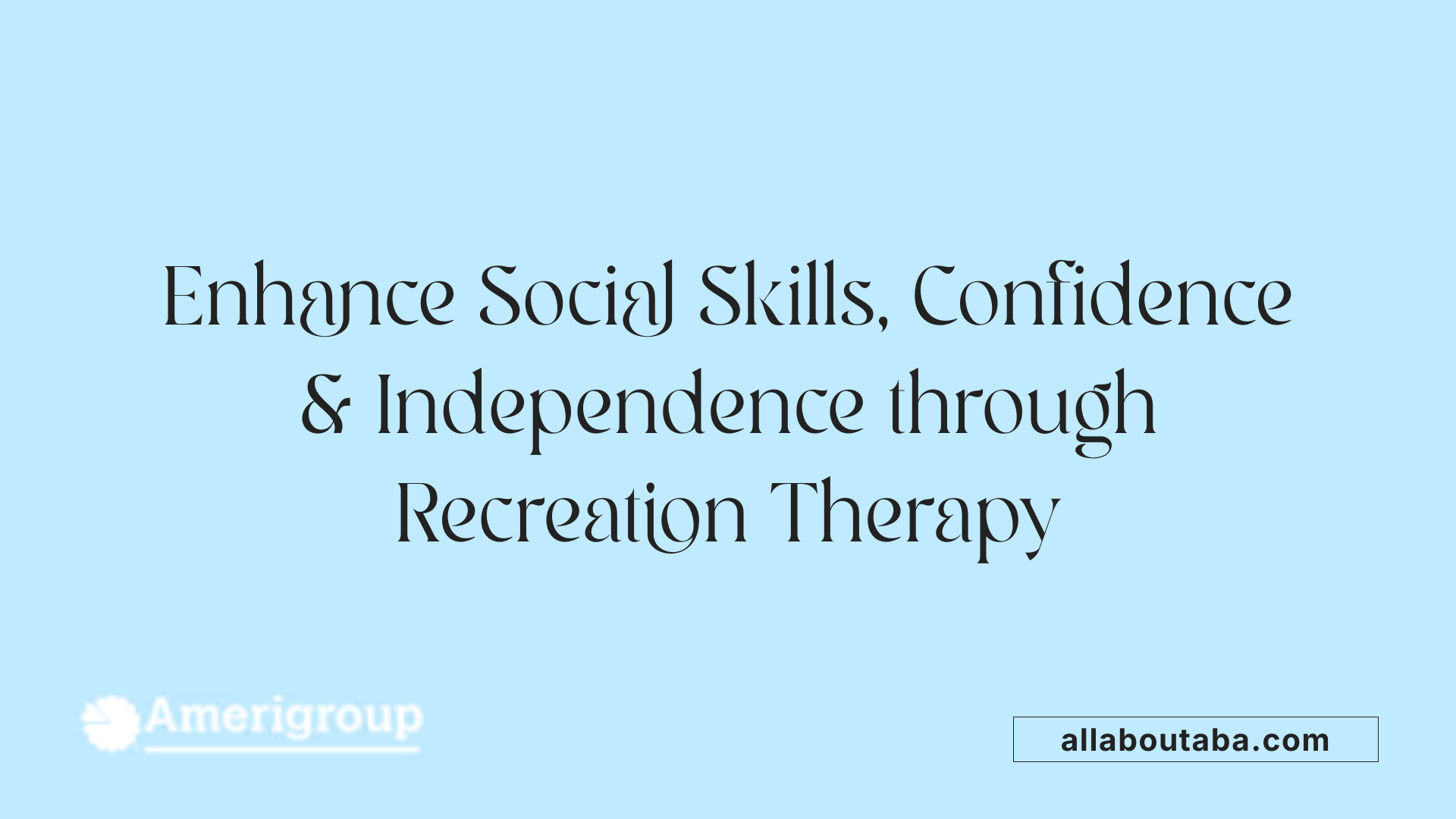 Recreation therapy and adaptive sports play a vital role in supporting individuals with autism by focusing on their unique needs and abilities.
Recreation therapy and adaptive sports play a vital role in supporting individuals with autism by focusing on their unique needs and abilities.
Tailored activities are designed to foster social interaction and communication. For example, structured group sports or art and music therapy provide safe environments where autistic individuals can practice social cues, express themselves, and develop interpersonal skills.
Participation in these activities also offers ample opportunities to make friends and join group settings. Engaging with peers in shared interests helps to build social networks and a sense of community, which are crucial for emotional well-being.
Structured adaptations and visual supports, such as communication boards or visual schedules, are used to facilitate understanding and reduce anxiety. These tools make activities more accessible and predictable, encouraging ongoing engagement and independence.
Participating in recreation therapy often leads to improved self-esteem and a sense of achievement. Successfully learning new skills or completing activities boosts confidence, motivating individuals to challenge themselves further.
Activities that are well-organized and inclusive help reduce feelings of anxiety and create a sense of belonging. These environments enable individuals with autism to feel accepted and valued within their community.
In addition to social benefits, recreation therapy supports the development of everyday life skills and self-advocacy. For example, organized sports may teach organizing equipment, following rules, and advocating for one's needs, which are transferable to daily and educational settings.
Research indicates that active participation in adaptive sports and recreational activities improves physical health, social interactions, and emotional resilience.
Overall, recreation therapy offers a comprehensive approach to enhancing social skills, confidence, and independence, empowering autistic individuals to lead more autonomous and fulfilling lives. It creates opportunities for personal growth and social integration that can impact multiple facets of everyday life.
| Aspect | Benefits | Examples |
|---|---|---|
| Social Skills | Improved communication, interaction | Team sports, drama clubs |
| Confidence | Self-esteem, sense of achievement | Completing activities, skill mastery |
| Independence | Self-advocacy, daily organization | Using visual supports, self-management |
| Emotional Well-being | Reduced anxiety, emotional regulation | Nature programs, art therapy |
| Community Engagement | Inclusion, social networks | Local clubs, adaptive recreation centers |
Innovative Approaches and Future Directions in Autism-Inclusive Recreation
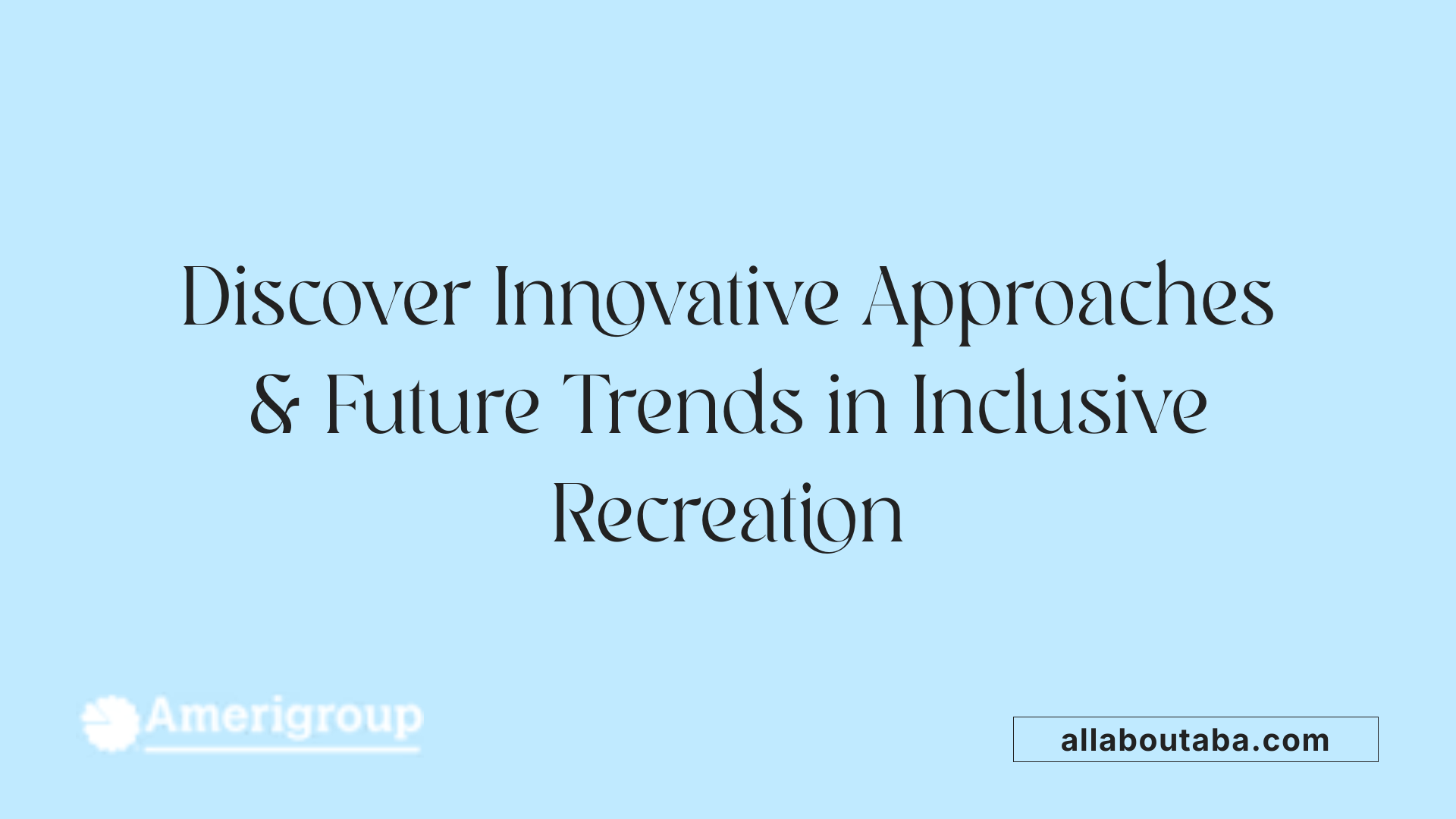
How can recreation therapy and adaptive sports support social skills, confidence, and independence in individuals with autism?
Recreation therapy and adaptive sports play a vital role in fostering social skills, building confidence, and promoting independence among individuals with autism. These programs are tailored to meet each person’s unique needs, providing opportunities for meaningful social interactions through group activities, team sports, and community participation.
By engaging in adapted sports like wheelchair basketball, sled hockey, or adaptive golf, individuals learn to communicate effectively, work as part of a team, and develop interpersonal skills. These activities also offer a sense of achievement, boosting self-esteem and reducing feelings of anxiety or depression.
Structured strategies such as visual supports, communication boards, and individualized plans make these activities accessible and enjoyable. Such adaptations help participants navigate new environments confidently, encouraging greater self-reliance.
Participation in recreation and sports helps develop skills critical for daily independence, including organizing equipment, self-advocacy, and managing routines. Over time, these experiences empower individuals with autism to lead more autonomous & fulfilling lives.
Furthermore, evidence shows that engaging in physical activities and social group settings improves overall mental well-being, physical health, and community involvement. Professionals and organizations are continuously developing innovative and personalized approaches to expand these benefits.
Future-oriented strategies focus on integrating emerging technologies like virtual reality and mobile apps to create engaging, sensory-friendly experiences tailored to individual preferences. These advancements can help reduce anxiety, provide safe environments for practice, and foster lifelong engagement.
Lifelong participation is increasingly emphasized, with programs evolving to support individuals at all ages and stages. Community involvement, policy support, and ongoing research are essential in developing inclusive recreational opportunities that adapt to changing needs.
By prioritizing personalized, accessible, and innovative recreational options, communities can better support individuals with autism, enabling meaningful social connections, greater confidence, and independence.
| Strategy Category | Examples | Benefits |
|---|---|---|
| Personalization | Interest-based programs, interest assessments | Increased motivation and engagement |
| Technology | Virtual reality environments, specialized apps | Reduce anxiety, promote practice |
| Community Support | Local organizations, policy advocacy | Broader access, sustainability |
| Lifelong Engagement | Adapted activities for different ages | Continuous development of skills |
Through expanding these approaches, the future of autism-inclusive recreation looks promising, aimed at fostering detailed integration into community life and enriching personal growth.
Fostering a Brighter Future for All Participants
Inclusive sports and recreational activities are transforming lives by providing essential opportunities for growth, connection, and self-expression. Through dedicated programs, community collaboration, and innovative approaches, we can continue to create environments where individuals with autism gain not only physical and mental benefits but also a sense of belonging and empowerment. Emphasizing participant involvement, flexibility, and accessibility ensures that these inclusive opportunities remain effective and impactful, paving the way for a more inclusive and supportive society for generations to come.
References
- Tips to create inclusive sports and recreation activities
- Autism and recreation
- Top Recreational Programs for Young Adults with Autism
- Adaptive Sports in the United States
- Exploring Recreation Therapy for Individuals with Autism
- Exploring Adaptive Sports: Opportunities for Recreation ...
- Exploring Recreation Therapy for Individuals with Autism
- Autism and recreation
Other articles
Recent articles

Best Ways To Foster Collaboration Between Parents And Schools For Autism Support

Supporting Autistic Children During Transitions Between Activities

The Role Of Teachers In Fostering Autism Peer Acceptance

Using Art Therapy To Support Children With Autism

Autism And Strategies For Addressing Sensory Defensiveness

Autism And The Benefits Of Structured Leisure Activities

How To Support Autistic Students During Exam Season

Autism And Goal Setting For Personal Growth

How To Use Gamification In Autism Learning Programs

How Schools Can Reduce Bullying Of Autistic Students

Early Intervention Strategies For Autism Spectrum Disorder

The Role Of Therapists In Autism Life Skills Coaching

How To Support Autistic Individuals In Crisis Situations

Autism And Self-Care Routines For Stress Management

Understanding Echolalia And Its Role In Autism Communication

Autism And Fine Arts Education Benefits

The Impact Of Multisensory Learning On Autism Education

How Family Counseling Supports Autism Household Dynamics

Best Practices For Inclusive Playgrounds For Autism

Best Practices For Autism-Friendly Shopping Centers

How Autism Affects Fine Motor Skill Development

Best Ways To Introduce Sensory Activities Into Daily Routines

How Sports Teams Can Be Inclusive Of Autistic Players

Autism And Strategies For Building Workplace Resilience

Autism And The Impact Of Hormonal Changes During Puberty

How To Support Autistic Students In Foreign Language Classes

Best Ways To Teach Money Skills To Teens With Autism

Supporting Siblings Of Children With Autism

Autism And Co-Occurring Gastrointestinal Disorders

The Role Of Art Projects In Autism Sensory Integration

How Schools Can Incorporate Sensory Break Spaces

Best Practices For Autism Sensory Regulation At School

Autism And Strategies For Teaching Organizational Skills

Understanding The Relationship Between Autism And Anxiety Disorders

Autism And Life Planning For Long-Term Care

Exploring Visual Supports In Autism Education

Ways To Encourage Social Interaction In Children With Autism

The Connection Between Autism And Dyscalculia

The Role Of Occupational Therapy In Transition Planning For Autism

The Role Of Physical Therapists In Autism Motor Skills Support

How To Teach Decision-Making Skills To Autistic Young Adults

The Connection Between Autism And Epilepsy

Best Practices For Transitioning Autistic Children Into New Schools

Autism And Time Management Challenges In Adulthood

The Role Of Visual Arts In Autism Communication Development

How To Address Tactile Defensiveness In Autism

Best Practices For Telehealth Autism Therapy

How To Help Autistic Children Develop Friendship Skills

How Schools Can Support Autistic Students In Career Prep

Best Strategies For Autism-Friendly Event Planning

Understanding Noncontingent Reinforcement In Autism Behavior Plans

How Drama Therapy Benefits Autistic Individuals

Best Practices For Autism-Friendly Fitness And Recreation Centers

Best Ways To Promote Healthy Social Media Use For Autistic Teens

How To Help Autistic Children Cope With Public Speaking

Autism And Strategies For Managing Unexpected Changes

Best Podcasts About Autism For Parents And Educators

Autism And The Impact Of Seasonal Changes On Behavior

The Role Of Diet In Managing Co-Occurring Conditions With Autism

Sleep Challenges In Autism And Practical Solutions

Best Ways To Build Daily Routines For Autistic Children

Best Practices For Supporting Autistic Entrepreneurs

Autism And Strategies For Navigating Large Social Gatherings

Adaptive Sports And Recreational Activities For People With Autism

Autism And The Benefits Of Story-Based Learning Activities

Understanding The Role Of Play In Autism Development

Autism And The Impact Of Environmental Noise On Learning

How To Create Autism-Friendly Community Spaces

Autism And Chronic Health Conditions: What To Know

The Role Of Care Managers In Autism Life Planning

How To Teach Social Boundaries To Autistic Children

How Autistic Individuals Experience Empathy Differently

How To Support Autistic Employees In Remote Work Settings

Autism And The Relationship Between Motor Skills And Learning

How To Create Community Resource Guides For Autism Families

How To Teach Daily Living Skills To Autistic Teens

Autism And The Impact Of Mind-Body Practices On Stress Reduction

Autism And The Benefits Of Outdoor Group Activities

How To Create Autism-Friendly Sensory Paths In Schools

Best Practices For Autism-Friendly Park And Recreation Areas

Autism And Strategies For Reducing School Refusal

Supporting Autistic Individuals In Public Speaking

The Role Of Diet In Managing Autism Symptoms

The Benefits Of Gardening Clubs For Autism Social Development

How To Prepare Autistic Children For Dental Visits

Autism And Employment: Career Paths That Work

Best Practices For Autism-Friendly Hotels And Lodging

The Impact Of Screen Time On Autism Development

Autism Screening Tools For Early Childhood

The Role Of Physical Exercise In Autism Therapy

Best Strategies For Supporting Autistic College Students

The Role Of Technology In Autism Early Detection

Sensory-Friendly Classroom Design Ideas For Autistic Students

The Role Of Speech Therapy In Building Social Communication Skills

Best Strategies For Handling Autistic Burnout In Adults

Autism And The Importance Of Predictability In Routine

Autism And Peer Education: Teaching Acceptance In Schools

Best Practices For Sensory-Friendly Libraries And Reading Rooms

Self-Advocacy Skills For Autistic Adults

The Role Of Technology In Autism Peer Communication
We’re All About You, Your Family, and Your Child

